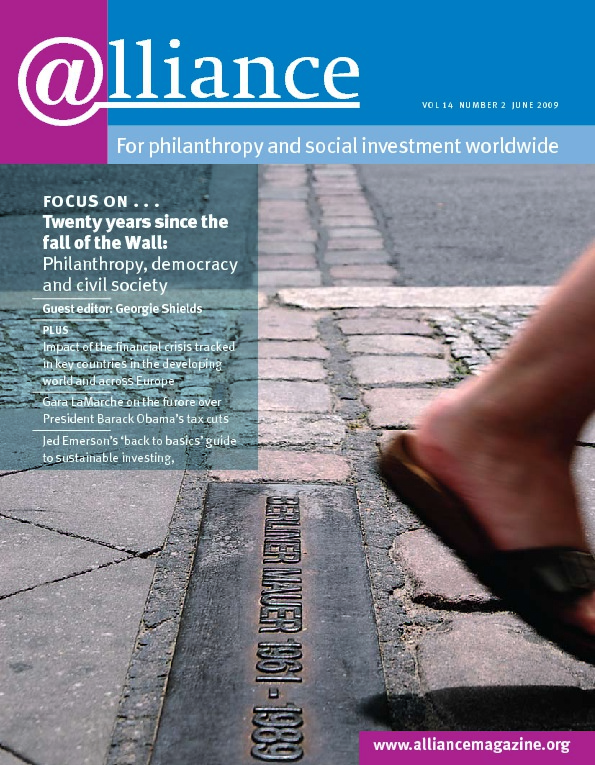Sobriety remains the primary message at the end of the second decade of Western civil society aid for post-communist societies, just as it was after the first, while the challenges and best practices I identified almost ten years ago (Alliance, March 2000) remain relevant today. But real achievements across the post-communist world emphasize that civil society development is still essential.
Back in 2000, I described the evolution from initial exuberance about the potential importance of emergent civil society actors to a growing recognition of the complexities, difficulties and limitations, I highlighted three factors likely to shape the context for such work during the first decade of the new century: failure or faltering of some of the hoped-for transitions to democracy; plateauing enthusiasm for NGOs as the core of civil society, and a shrinking pool of Western aid for civil society development.
Despite some surprises in the post-communist world – the rose and orange revolutions in Georgia and Ukraine in 2003 and 2004, for example, and the resultant backlash against civil society assistance – these nascent trends did come to pass. Russia’s authoritarian slide of recent years has been the most significant but hardly the only faltering transition. Indeed, after a decade of bad news about democratization in most of the former Soviet Union, the label of democratic transition applies only in a few places. NGOs remain valuable actors but their initial loss of lustre in the late 1990s has continued and today few people view them as a major element of their country’s sociopolitical life. The sources of external aid for civil society development have shrunk in number and size because aid organizations have ‘graduated’ many countries from their recipient lists or been shut out of others.
It is striking, and perhaps also somewhat discouraging, that what I posited in 2000 as five core challenges for civil society assistance in the first decade of the new century could largely stand as a road map for the next ten years: connecting civil society development to the task of overcoming weak political party development; broadening civil society aid beyond NGOs; looking harder at how civil society development can foster positive change in semi-authoritarian contexts; continuing active civil society support in the former Yugoslav republics to support stability and European integration; and committing the necessary resources to meet the daunting challenge of bolstering civil society in the former Soviet republics.
That the principal challenges of ten years ago remain very much with us today could be taken as a sign that little or nothing has been accomplished by civil society aid in the intervening years. This would be too harsh. Civil society aid has fortified many organizations and individuals in making numerous valuable contributions. In Slovakia, activist civic groups have helped protect open political space against illiberal political forces at key junctures. In Romania, sophisticated anti-corruption advocacy by civil society groups has made a dent in systemic political corruption. In Bulgaria, a notably vibrant think-tank sector has aerated Bulgarian political life with useful new ideas. The continuing relevance of that decade-old agenda is not a sign of failure but rather an indication that the overall task of strengthening civil society is inherently much longer-term than enthusiasts imagined in the early post-communist years.
Similarly, the emergent best practices for civil society aid that I set out in my earlier article remain a mix of aspirations and only very partial accomplishments. For example, the admonition to focus on sustainability, by helping NGOs diversify their donor support, develop local sources of funding, and build local habits of corporate philanthropy, is entirely relevant today. So, too, is the recommendation to establish mechanisms and incentives through which well-established NGOs can provide training to less well-established groups. But the donor community is not completely stuck. Civil society aid has become more sophisticated, at least in parts, as aid organizations accumulate a greater understanding of how aid affects recipient countries. At the same time, learning lessons has been at best a slow, iterative, and sometimes scattered process.
In sum, the sobriety I invoked ten years ago about the recent past and likely future of civil society assistance is still a helpful guiding framework. Civil society development remains a vital endeavour, one that civil society assistance is still struggling to undertake.
Thomas Carothers is vice president for studies at the Carnegie Endowment for International Peace. Email tcarothers@ceip.org
Thomas Carothers’ article on ‘Aiding civil society in post-communist societies’ in the March 2000 issue of Alliance was part of a special feature assessing ten years of support to civil society in Central and Eastern Europe and the Former Soviet Union.


Comments (0)